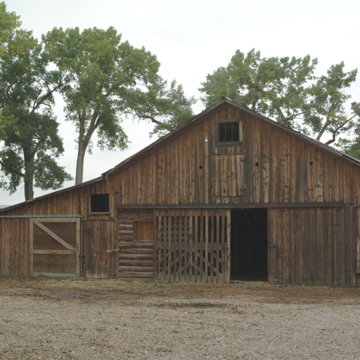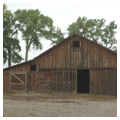The TA Ranch near Buffalo was established by Dr. William Harris of Laramie, who purchased a herd of cattle and moved it to land near the North Fork of Crazy Woman Creek in Johnson County in 1882. Johnson County, located between the Bighorn Mountains and the Powder River in the northeast quadrant of Wyoming, was known for its excellent grazing land. Harris filed for water rights and built a barn, ranch house, ice house, and chicken coop on his ranch. He was not actively involved in the operation, however. Like other “cattle barons” of the period, he left the ranch in the hands of his ranch manager while continuing to practice medicine in Laramie.
The TA’s original ranch house is a low, one-story, rectangular log structure topped by a gable roof. The logs are sawn on all four sides with a circular saw, unusual for nineteenth-century log buildings in Wyoming. The log ends are nailed into vertical logs at each corner. The house has no interior hallway; instead, each of the five major rooms has an exterior door opening to the south. At one point during its history, the logs were covered with stucco, which was removed during a restoration in the 1990s. The south-facing barn is a simple western version of the Midwest three-portal barn, with a central stable area with haymow above, capped by a gable roof. One-story, shed-roofed additions flank each side of the central portion. The walls of the original center section are log, but the entire building has been sheathed in board-and-batten siding. The associated interior stalls and exterior corrals are still intact.
The semi-arid high plains grasslands of Johnson County were home to many corporate ranchers such as Harris, as well as an increasing number of smaller, owner-operator ranchers, lured to the area by the booming cattle industry and a series of Homestead Acts allowing for the cheap acquisition of land. As the cattle industry continued to grow, what seemed like an endless landscape began to suffer under the pressure of thousands of herds. Cattle health faltered as grass and water resources could not keep up with the high concentration of animals, and market prices began to dip. The wealthy absentee cattle barons in the Wyoming Stock Growers Association (WSGA) became increasingly concerned that their open ranges were being infringed upon by homesteaders, whom they also accused of collecting stray cattle and rebranding them as their own.
In 1892, the TA Ranch became the site of the largest standoff of the Johnson County War (also known as the Wyoming Range War), when WSGA members gathered a 22-man posse in Cheyenne and traveled north with the intention of scaring off the so-called cattle rustlers. After killing several owner-operators, the stockgrowers (called the “invaders” by the locals) holed up in the barn at the TA Ranch. An angry posse of hundreds of local Johnson County ranchers surrounded the invaders at the TA Ranch, and besieged them for three days before U.S. Army cavalry troops came in and ended the battle.
Following the war, there were a series of booms and busts in the cattle industry. Harris continued to own the TA Ranch until 1904, when he traded the property to J.P. Gammon for some land east of Johnson County. Gammon brought several hundred head of Percheron cattle to the ranch to pull machinery, and continued to use them through World War II. Harris and Gammon erected additional outbuildings on the ranch, including a bunkhouse/blacksmith shop, milk barn, cattle shed, hog barn, meat house, and granary. Most of the original buildings remain on the ranch today, and are used in the current operation, a working ranch that also functions as a guest ranch and convention center. The original ranch house is used for guest rooms, and the barn is still used in the ranching operation.
The cookhouse, built of hand-hewn logs in 1894, with an addition in 1906, now has a more recent addition and serves as the family-style dining room and common area for the guest ranch and ranch hands. The log bunkhouse/blacksmith shop (1892) has been converted into five guest rooms with kitchen and living room. The granary (1911) has been converted into a meeting space and additional guest rooms.
The TA Ranch buildings are the last remaining intact structures from the Johnson County War. The barn still has bullet holes and the portholes carved in its walls for rifle sights by the invaders holed up inside. Rifle pits and other breastworks constructed by the locals are also still visible on the ranch.
References
Wyoming State Historic Preservation Office, “TA Ranch Historic District,” Johnson County, Wyoming. National Register of Historic Places Registration Form, 1992. National Park Service, U.S. Department of the Interior, Washington, D.C.





















